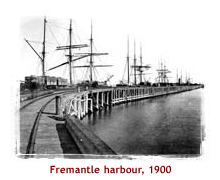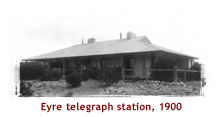 |
Isolation 1900
 When
Western Australia joined the Federation it was only just starting to emerge
from seven decades of isolation. The completion of the port facilities at
the newly dredged Fremantle harbour in 1898 gave the colony the modern port
it so desperately needed. The first mail steamers called at Fremantle in
1900, bringing with them a sprinking of travellers, immigrants, and increased
trade. They also brought the feeling that most of the people who lived in
Western Australia were no longer as isolated from the rest of the world
as they had once been. When
Western Australia joined the Federation it was only just starting to emerge
from seven decades of isolation. The completion of the port facilities at
the newly dredged Fremantle harbour in 1898 gave the colony the modern port
it so desperately needed. The first mail steamers called at Fremantle in
1900, bringing with them a sprinking of travellers, immigrants, and increased
trade. They also brought the feeling that most of the people who lived in
Western Australia were no longer as isolated from the rest of the world
as they had once been.
Until the new harbour was completed Fremantle had been a dangerous and infrequently
used port. Previously the big mail steamers had called at Albany, which
enjoyed one of the finest natural harbours in the world, but was too remote
from the colony's major population centres to be a true commercial centre.
With Perth the central hub of the colony's railway network it was essential
that Fremantle become the major port for exporting and importing produce.
 Western Australia in 1900 was still a remote and isolated part of the British Empire. There was little to connect the colony with the rest of Australia apart from the Overland Telegraph which had been in operation since 1877. The main benefit of the telegraph in the minds of most Western Australians, was improved communication with London. Western Australia in 1900 was still a remote and isolated part of the British Empire. There was little to connect the colony with the rest of Australia apart from the Overland Telegraph which had been in operation since 1877. The main benefit of the telegraph in the minds of most Western Australians, was improved communication with London.
In 1900 the only telephone lines in existence were local, the first having connected Perth with Fremantle in 1887. The railway system, also begun in the late 1870s, extended as far east as the goldfields, and went no further. Travel to the eastern colonies took at least five days by steamer, and travel to Britain took several months.
|
 |